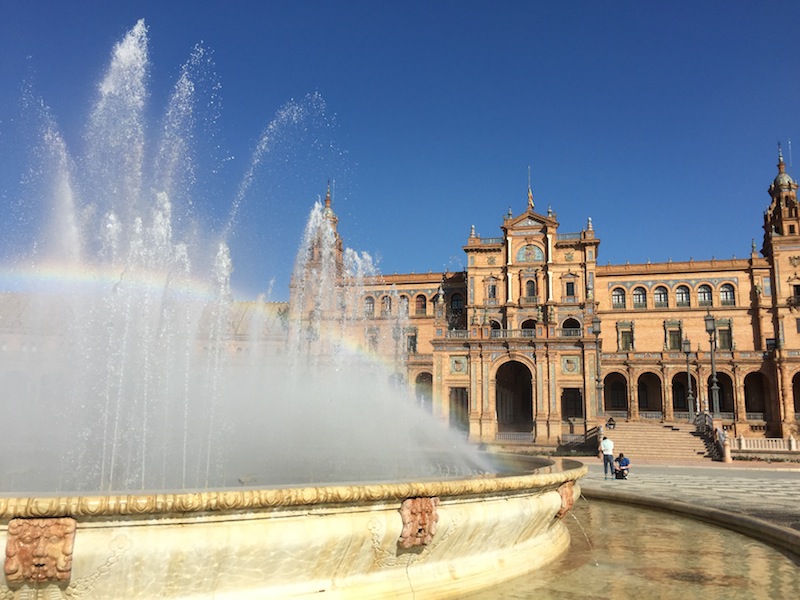Picking a good hotel is all about research and we’re in the habit of choosing some great ones. The Palacio de Villapanes ranks among them.
Once the home of a noble Seville family, it boasts luxury bedding, great service and fancy design. A giant coat of arms on the grand marble staircase is one of the few reminders of the days when aristocrats roamed the corridors rather than tourists and business folk with expense accounts.
The hotel is on the edge of the Santa Cruz district, the old Jewish quarter. The barrio itself is a maze of cool alleys and cobbled streets, of small squares shaded by the ubiquitous Seville orange trees. The buildings huddle up against each other, historic and picturesque, providing much-needed shelter on the hottest summer days.
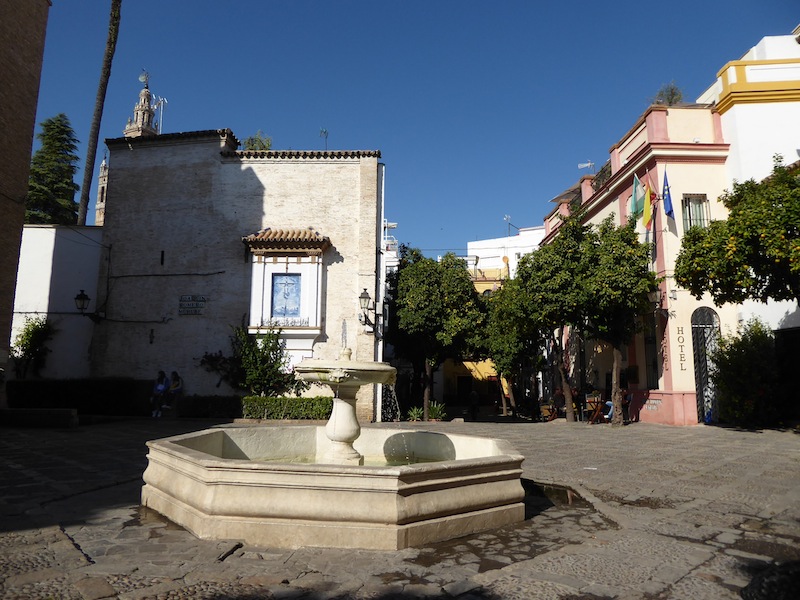
But when we were exploring we did have to watch our step because there was dog shit everywhere. Either Seville’s dogs have a very shit-inducing diet or their owners are the laziest fuckwits about. And people talk about French dog owners…
We didn’t have to walk far and therefore dodge too much crap to discover the grand noble house, the Casa de Pilatos. Dating from the 15th century and the work of the Enríquez and Ribera families, it’s name derives from the fact that someone thought it mirrored the palace of Pontius Pilate. It’s still the home of an old aristocratic family so it’s not just a dusty museum, and it sits on a large plot, hidden from the street beyond, wrapped around a number of private courtyards and gardens.
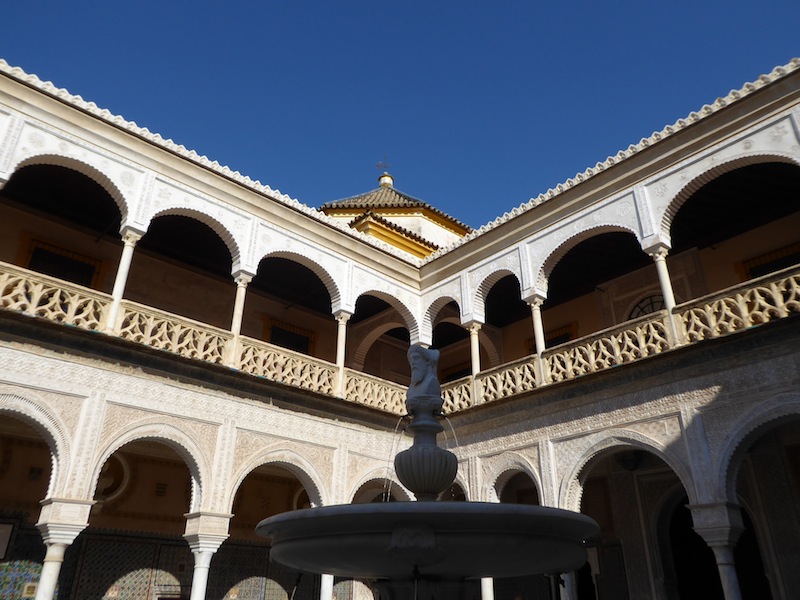
Like the Alcazar, it’s a fabulous mix of Mudejar, Gothic, Renaissance and romantic architectural styles. We entered into the highlight of the palace, the two-storey central courtyard. This white marble dazzler of a space is surrounded by irregular arches and statues of goddesses, while a tinkling fountain graces the centre. Colourful, centuries-old tiles line the walls both in the courtyards and in the sometimes gloomy downstairs rooms, which were used in the summer when the second floor was just too hot. The tiles mirrored the tapestries found in the upstairs rooms, which the family used in the winter months.
We wandered around, taking in the decoration, accompanied by one of those terribly tedious commentaries on a handset. Why is it so many attractions kill the moment with such worthy, dull and neverending stories? I marvelled instead at the carving in the doors and walls, as exceptional as it was at the Alcazar.
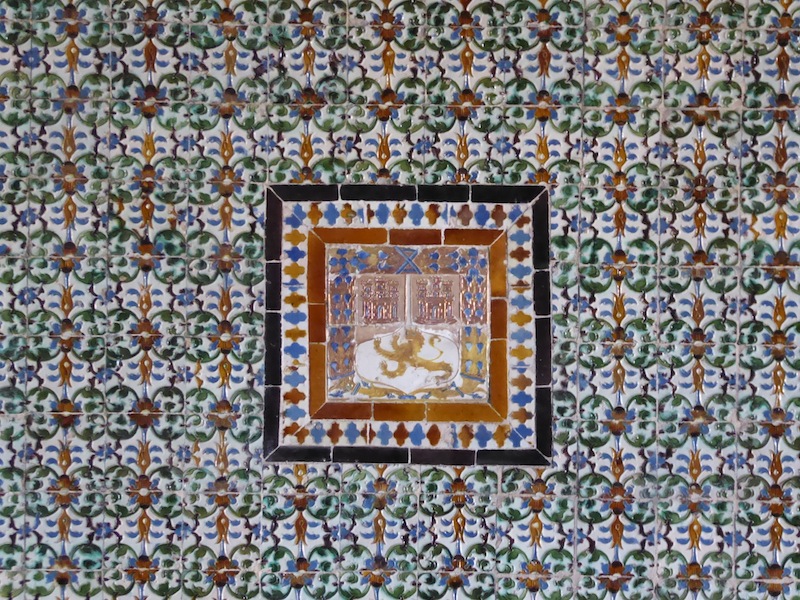
After exploring the gardens, we walked up the grand and intricately decorated staircase to the upstairs rooms for a proper tour. We found walls boasting the remains of fine frescoes and sometimes dusty rooms furnished in a range of styles, but we weren’t allowed to dawdle and the commentary was more about the art and furnishings than the family itself. All too often, tour guides miss the human angle and an opportunity to create lively and engaging stories in the mistaken belief that everyone is as interested in a drab portrait of a 400-year-old worthy as they are.
We left, going deep into Santa Cruz, drinking in the atmosphere, dodging shit and tourists. It was sunny again, in the mid-20s. We stopped for a beer and watched sparrows skitting about and kids playing by the fountains.

The Avenida de la Constitución came as a bit of shock after all the narrow alleys, a wide street with trams and all the signs of globalisation – the depressingly inevitable Starbucks and fast food joints. Apart from some fine architecture, it held little appeal. So we walked up past the Fabrica de Tabacos, probably the most elegant of factories ever built but now a university building. Our target was the Plaza de Espana, constructed for the 1929 Expo and a huge, palatial, semi-circular brick building with towers, balconies and views. It’s also a bit of a sun trap.

Rowing boats, popular with families with children, drifted lazily on a canal out front while we wandered around, looking at some of the 40 or so alcoves built into the structure, each with an elaborately tiled tableau and map representing the various Spanish regions. The building – which Graham assured me had been used as a set in a Star Wars film – is now local government offices so we didn’t go inside. Instead, we walked into the neighbouring Parque de Maria Luisa, which looked a bit scrappy to me but is home to some fine mansions built for the expo. Numerous horses and carriages were lined up nearby and even with my cold I could smell them.
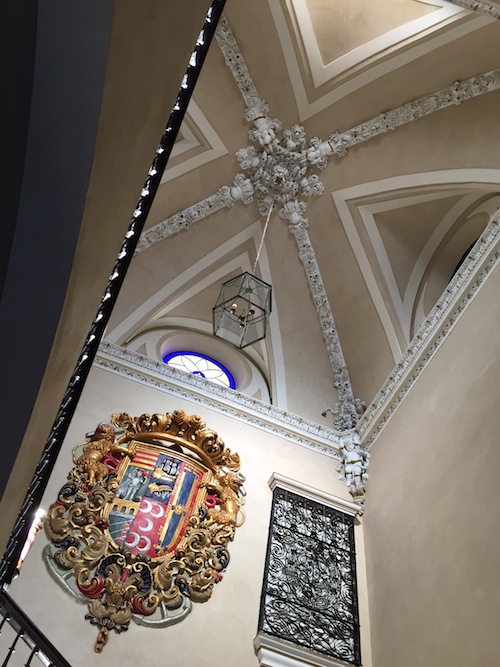
After freshening up at the hotel, we ended up back near the cathedral for dinner. My starter with some delicious anchovies came with the largest lettuce yet found on Planet Earth but even having consumed it all and with leaves oozing from every orifice, I managed to stuff a main course down too.
We concluded the evening just off the Plaza Alfafa, in Bar Alfafa. Small, perfectly formed, full of atmosphere and with people spilling out onto the pavements outside, it was an absolutely ideal place to end the night.
But why do they serve beer in such small glasses in Spain?

